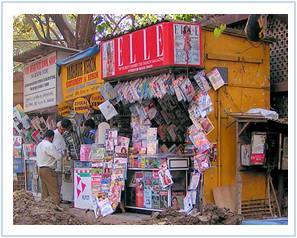Feature | How newspapers are eying bigger growth from smaller towns of India...
A senior official from Hindustan said, "It is very evident from IRS data that time spent online by the urban audience has gone up by a significant amount while time spent reading has stagnated. This is primarily because the online media is more responsive and can be updated immediately. Also the audience is free to choose between several sources, most of which come free of cost. Also sites like twitter have made sharing information really easy."
Smaller markets are in the process of undergoing unparalleled growth from all sectors. This increases the per capita income of an average person and it leads to increasing purchasing power. Publications are trying to exercise this fact. According to the IRS report's "Household Potential Index', the overall living standard of Indian population is going up. Also according to another IRS data, there has been a substantial increase in the online time spent by readers reading over the last four years. In 2009, in fact, there has been a decline in the amount of time spent reading print media by the consumers. The education levels in these markets are increasing and thus there is better literacy rate prevailing now. The growth in the mobile sector is coming from the smaller markets. Today 80% of these smaller markets may not have access to a computer but there is an easy access to mobiles. Marketers are conscious about this changing scenario and completely leveraging upon this.
He further said, "Small town India has really come of age in terms of consumer spending. States like Bihar are seeing stratospheric growth in consumption and hence most corporations are eyeing these markets to provide their next round of growth. The language daily is an excellent and in many cases the only way to reach this class and hence the focus. Bihar where Hindustan is the number one player had a literacy rate of only 47%. However that state is growing at a blistering pace now and literacy levels have improved tremendously. As more and more people get literate their information consumption will increase. As the internet is yet to penetrate deep into the Indian heartland print continues to flourish here. Also with growth momentum in small town India more and more advertisers are looking at these regions to expand their consumer base. Language dailies can take advantage of this new source of revenue and pass on some of the gains to the consumer in the form of reduced prices. This will also increase readership"
Bharat Kapadia, Director on Board, Lokmat, said "The reasons for this increased focus on smaller markets are due to various factors. Increased literacy levels have a direct influence on reading a newspaper and the desire to keep one informed. Semi urban folk also aspire like their urban neighbors which means increased consumption and therefore they are constantly seeking info. Local manufacturers also compete with major players in their region. Hence local players also require a window. Metro markets are more or less saturated. Hence marketers are moving inwards. Also please remember that it makes sense for a regional newspaper to grow organically too, as they have a strong regional identity. Once a particular geographical area gets penetrated it is but natural to make inroads into the next geographical neighboring region sharing the common language and socio cultural ethos."
Sanjeev Kotnala VP, BrandComm, Bhaskar Group said, "NON-METRO and KUT (Key Urban Towns) will define further growth for brands and services and hence will also define the growth of the regional / language newspapers. The brands will further focus on these, with enhanced infrastructure and higher rate of growth in income, faster rate of growth in consumption- they are ripe markets of huge volumes."
Agencies are also in sync with the increase focus in smaller markets.
Mausumi Kar, General Manager, North-East, Maxus, said, "Size is a matter of perspective. Market potential defines focus for advertisers. Many consumer durable companies are now looking at "so -called" smaller markets with specific offerings."
With technology and time, the media penetration is more now in smaller markets which enables for a wider reach of audience. More and more people can now afford to buy television sets and mobiles from the smaller markets.
Mausumi Kar further adds, "Penetration of TV and digital has definitely gone up. However, what's more important is that regional TV channels are entering these markets. Clearly, there is need and there are takers. Market potential dictates such exigencies. It is sometimes a chicken an egg story. Sometimes latent demand and sometimes market expansion needs dictate foray into smaller markets. Infrastructure in some cases makes entry into smaller markets challenging."
According to Suresh Nimbalkar, VP, Hansa Research, "Print marketing has come of age. Today, you find experienced FMCG marketers taking up management positions at publications. You see quite a few publications being designed by international designers. Content requirements are assessed on an ongoing basis. Brand health is tracked on regular basis. The tactics of ensuring minimum base circulation at the launch (through listing and attractive subscription offers) are more commonplace. The days of "This is my market and that is publication X's market' are gone. Publishers today understand that advertisers pay the premium for reach and not frequency. Hence, it is imperative for publishers to increase reach in order to increase advertising revenue. Publishers also understand that from advertiser's standpoint, urban consumers are more valuable than rural ones due to higher consumption levels. It's dailies which are expanding. Dailies has always had to grapple with distribution problems as "News' is a perishable item. As a result, a daily's reach was limited (unlike magazines). For a daily, a market becomes more or less saturated in 2-3 years time and they need to look at geographical expansion to increase reach"
So this leads us to ask if the bigger markets are saturated and hence the evident shift in focus. However with the markets growing at an exponential scale, it is difficult to agree with this statement.
"Bigger markets are not exactly saturated. However, once a publisher covers big markets in his region, the only way he can go is to smaller towns. It's also easier to challenge the small publications in smaller towns than take-on to an established publication in other bigger markets in different regions. From market saturation perspective, big metros are not exactly saturated. However, like mobiles, the readership growth has shifted to smaller towns and villages. Readership growth in metros is subdued. Readership growth is higher in 5-10 lakh towns and 5000 plus villages. The ratio of "Any Publication Readership" to "Literates' indicates potential for readership. This ratio is more or less constant for 1 lakh + towns (about 70%). It is lower for rural, indicating future growth potential. Readership is catching up in SSC/HSC and Graduate / postgraduate education brackets. This is because education profile of the population is going up" Nimbalkar further added.
So whether it is increased media penetration or increased literacy levels, the focus on smaller markets is here to stay. It is important to note that with time these smaller markets have empowered themselves and made it clear that no IRS report can exist without their inclusion. Publication houses and other media owners are initiating a better marketing and communication strategies so as to reach out to an audience that was untapped before. | By Janees Antoo [janees(at)adgully.com]


















Share
Facebook
YouTube
Tweet
Twitter
LinkedIn